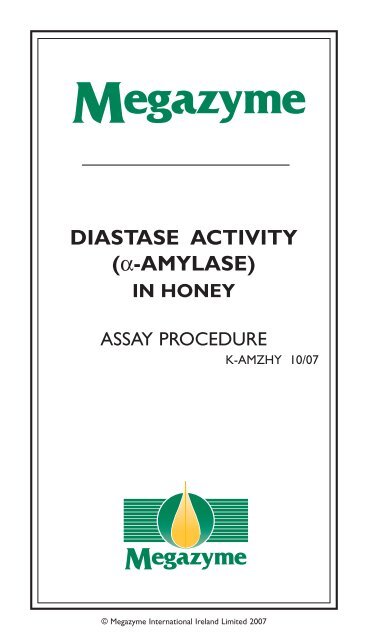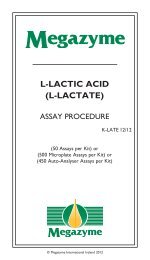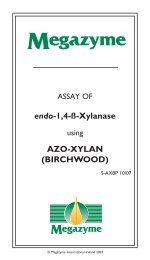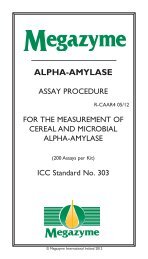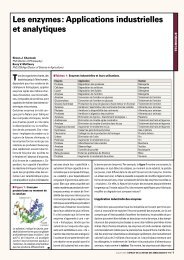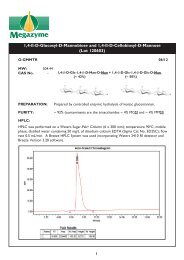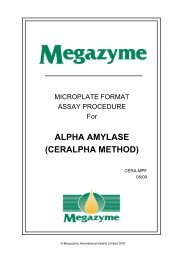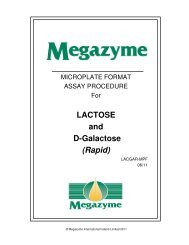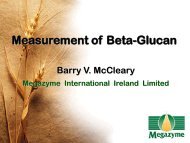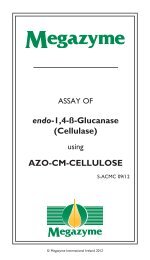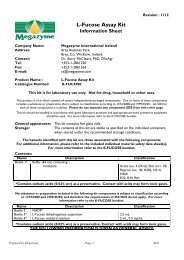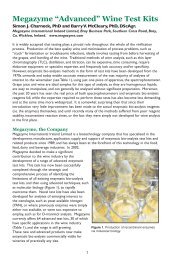Amylase in Honey - Megazyme
Amylase in Honey - Megazyme
Amylase in Honey - Megazyme
Create successful ePaper yourself
Turn your PDF publications into a flip-book with our unique Google optimized e-Paper software.
DIASTASE ACTIVITY<br />
(α-AMYLASE)<br />
IN HONEY<br />
ASSAY PROCEDURE<br />
K-AMZHY 10/07<br />
© <strong>Megazyme</strong> International Ireland Limited 2007
INTRODUCTION:<br />
The traditional method for the measurement of diastase activity <strong>in</strong><br />
honey isthe Schade procedure 1 . One unit of diastase activity (or<br />
more specifically, α-amylase), the Schade or Gothe unit, is def<strong>in</strong>ed as<br />
that amount of enzyme which will convert 0.01 gram of starch to the<br />
prescribed end-po<strong>in</strong>t <strong>in</strong> one hour at 40°C under the conditions of the<br />
test. Results are expressed <strong>in</strong> Schade units per gram of honey and<br />
termed Diastase Number (DN). In this assay, a standard solution of<br />
starch, capable of develop<strong>in</strong>g, with iod<strong>in</strong>e, a colour <strong>in</strong> a def<strong>in</strong>ed range<br />
of <strong>in</strong>tensity, is acted upon by the enzyme <strong>in</strong> the sample under<br />
standard conditions. The dim<strong>in</strong>ution <strong>in</strong> the blue colour is measured at<br />
<strong>in</strong>tervals. A plot of absorbance aga<strong>in</strong>st time, or a regression equation,<br />
is used to determ<strong>in</strong>e the time t x required to reach the specified<br />
absorbance, 0.235. The Diastase Number is calculated as 300 divided<br />
by t x , provided the method is followed precisely.<br />
More recently 2 , an alternative procedure employ<strong>in</strong>g Phadebas ® test<br />
tablets was <strong>in</strong>troduced, and subsequently updated 3 . This method is<br />
based on the use of an <strong>in</strong>soluble, dyed starch substrate. As this<br />
substrate is hydrolysed by α-amylase, soluble dyed starch fragments<br />
are released <strong>in</strong>to solution. The reaction is term<strong>in</strong>ated and <strong>in</strong>soluble<br />
substrate removed by centrifugation. The absorbance of the<br />
supernatant solution (at 620 nm) is directly proportional to the<br />
diastase activity of the sample. This procedure has been widely<br />
adopted with<strong>in</strong> the honey <strong>in</strong>dustry due to the convenience of a<br />
commercially available substrate and the simpler assay format.<br />
However, the production and supply of Phadebas ® tablets has ceased,<br />
leav<strong>in</strong>g a need for an alternative product. In 1992, <strong>Megazyme</strong> ®<br />
developed Amylazyme tablets for the measurement of α-amylase<br />
(diastase activity) <strong>in</strong> cereal and food products. These tablets are now<br />
widely used <strong>in</strong> the cereals and food <strong>in</strong>dustries and an assay format<br />
based on their use is a recommended procedure of the American<br />
Association of Cereal Chemists (AACC Method 22-05) 4,5 for the<br />
measurement of α-amylase <strong>in</strong> cereal gra<strong>in</strong>s and flours. These tablets<br />
can readily be adapted to the measurement of α-amylase (diastase<br />
activity) <strong>in</strong> a range of food products <strong>in</strong>clud<strong>in</strong>g honey.<br />
PRINCIPLE:<br />
Amylazyme tablets, <strong>in</strong> pr<strong>in</strong>ciple, are very similar to Phadebas ® tablets.<br />
Amylazyme tablets conta<strong>in</strong> dyed and crossl<strong>in</strong>ked amylose (the l<strong>in</strong>ear<br />
fraction of starch). When these tablets are added to buffer solution,<br />
they rapidly hydrate and the particles of dyed, crossl<strong>in</strong>ked amylose<br />
absorb the buffer solution. In the presence of α-amylase, the<br />
substrate is hydrolysed and soluble dyed products are released. The<br />
1
eaction is term<strong>in</strong>ated and, follow<strong>in</strong>g filtration, the absorbance of the<br />
filtrate is measured at 590 nm. The absorbance of the filtrate is<br />
directly proportional to the diastase activity of the sample. A major<br />
advantage of Amylazyme over Phadebas ® (other than the fact that the<br />
latter tablets are no longer available), is that the degree of crossl<strong>in</strong>k<strong>in</strong>g<br />
<strong>in</strong> the Amylazyme tablets has been optimised to ensure rapid<br />
hydration and swell<strong>in</strong>g of the substrate. In practice, this means that<br />
the tablet can be added to the enzyme conta<strong>in</strong><strong>in</strong>g solution, and the<br />
reaction performed with no need for stirr<strong>in</strong>g or shak<strong>in</strong>g of the<br />
<strong>in</strong>cubation mixture. The assay format has been adjusted to take<br />
advantage of this property.<br />
S<strong>in</strong>ce the standard units employed by the honey <strong>in</strong>dustry are Schade<br />
units, for this application, the Amylazyme has been standardised <strong>in</strong><br />
Schade units. A curve show<strong>in</strong>g the relationship between absorbance<br />
at 590 nm (Amylazyme tablets) and Schade units based on the dilution<br />
of a s<strong>in</strong>gle standardised honey solution is shown <strong>in</strong> Figure 1.<br />
A correlation between Schade units and <strong>in</strong>crease <strong>in</strong> absorbance at<br />
590 nm (Amylazyme tablets) is shown <strong>in</strong> Figure 2. Use of the latter<br />
curve is recommended for the calculation of enzyme activity.<br />
SPECIFICITY AND LINEARITY:<br />
The Amylazyme test is absolutely specific for α-amylase. For α-amylase<br />
<strong>in</strong> a diluted honey sample, the curve is l<strong>in</strong>ear over the absorbance range<br />
of 0.1 to 1.2 absorbance units but does not <strong>in</strong>tersect the orig<strong>in</strong><br />
(Figure 1). In a comparison of the diastase activity <strong>in</strong> a number of<br />
samples analysed by the Schade method and the Amylazyme procedure,<br />
aga<strong>in</strong> the l<strong>in</strong>e of best fit is l<strong>in</strong>ear and does not <strong>in</strong>tersect the orig<strong>in</strong>. The<br />
regression equations are very similar, however, some samples deviate<br />
significantly from the curve of best fit. The reason for this is not clear.<br />
INTERFERENCE:<br />
The assay can be applied to all honey samples. At the sample dilution<br />
used, the concentration of sugars <strong>in</strong> the samples appears to neither<br />
<strong>in</strong>terfere with enzyme activity or the filtration process.<br />
SAFETY:<br />
The reagents used <strong>in</strong> the determ<strong>in</strong>ation of diastase activity <strong>in</strong> honey<br />
are not hazardous materials <strong>in</strong> the sense of the Hazardous Substances<br />
Regulations. The general safety measures that apply to all chemical<br />
substances should be adhered to.<br />
2
REAGENTS AND SOLUTIONS:<br />
All reagents must be of analytical grade.<br />
1. Amylazyme tablets.<br />
Available from <strong>Megazyme</strong> <strong>in</strong> packs of 200 or 1,000 tablets. Ensure<br />
that the lot number relates to the standard curve <strong>in</strong> the booklet.<br />
Stable at room temperature for > 5 years.<br />
2. Sodium maleate buffer (100 mM, pH 5.6) plus calcium<br />
chloride (5 mM).<br />
Add 11.6 g of maleic acid (Sigma cat. no. M-0375) and 0.735 g of<br />
calcium chloride.dihydrate (CaCl 2 .2H 2 O) (Sigma cat. no.<br />
C-5080) to 800 mL of distilled water and adjust the pH to 5.6<br />
with 2 M (8 g/100 mL) sodium hydroxide solution. Adjust the<br />
volume to 1 litre. Store the buffer <strong>in</strong> a 1 L Duran ® bottle and<br />
overlay the solution with 2 drops of toluene to prevent microbial<br />
contam<strong>in</strong>ation. Stable at 4°C for approx. 2 months.<br />
3. Trizma base solution.<br />
Add 20 g of Trizma base (Sigma chemical company, cat. no.T-1503)<br />
to 900 mL of distilled water and dissolve. Check the pH and<br />
adjust to approx. 8.5 if necessary. Adjust the volume to 1 L with<br />
distilled water. Stable at room temperature for 12 months.<br />
EQUIPMENT (RECOMMENDED):<br />
1. Glass test tubes (round bottomed; 16 x 120 mm, ~ approx. 17 mL<br />
capacity).<br />
2. Micro-pipettor, e.g. Gilson Pipetman ® (1 mL) for dispens<strong>in</strong>g enzyme<br />
conta<strong>in</strong><strong>in</strong>g solutions.<br />
3. Positive displacement pipettor e.g. Eppendorf Multipette ®<br />
- with 25 mL Combitip ® (to dispense buffer and diluted enzyme<br />
preparations).<br />
4. Adjustable-volume dispenser (set at 10 mL) for dispens<strong>in</strong>g Trizma<br />
base solution).<br />
5. Analytical and top-pan balance.<br />
6. Spectrophotometer set at 590 nm.<br />
7. Thermostated water bath set at 40°C (eg. Julabo PC ® ).<br />
8. Vortex mixer (e.g. IKA ® Yellowl<strong>in</strong>e Test Tube Shaker TTS2).<br />
9. Stop clock.<br />
10. Whatman No.1 (9 cm) filter papers and filter funnels.<br />
3
CONTROLS AND PRECAUTIONS<br />
1. The time of <strong>in</strong>cubation of the enzyme extract with the<br />
Amylazyme tablet must be carefully controlled (i.e. 10.0 m<strong>in</strong>).<br />
2. Incubation temperatures must be accurately controlled<br />
(i.e. 40 + 0.1°C).<br />
3. When the Trizma base solution is added to the reaction tube, the<br />
tubes must be stirred vigorously to ensure thorough mix<strong>in</strong>g.<br />
Leave the tubes at room temperature for 5 m<strong>in</strong> and stir the<br />
contents aga<strong>in</strong> before filtration.<br />
4. Follow<strong>in</strong>g the addition of the Trizma base solution to the reaction<br />
tubes, the tubes must be stored at room temperature. At room<br />
temperature, the substrate suspension is stable for at least 1 h.<br />
If this alkal<strong>in</strong>e mixture is left <strong>in</strong> the water bath at 40°C, the dyed<br />
substrate will slowly degrade lead<strong>in</strong>g to elevated absorbance<br />
values on filtration.<br />
5. With each set of analyses a s<strong>in</strong>gle reaction blank should be<br />
run. This is performed by add<strong>in</strong>g an Amylazyme tablet to the<br />
sodium maleate buffer and proceed<strong>in</strong>g as for the enzyme assays.<br />
6. Test tablets should be stored dry <strong>in</strong> well sealed conta<strong>in</strong>ers at<br />
room temperature.<br />
7. The Amylazyme assay is affected by the concentration of buffer<br />
salts. The optimal buffer salt concentration is 100 mM.<br />
PREPARATION OF HONEY SAMPLES FOR ANALYSIS:<br />
1. S<strong>in</strong>ce the α-amylase activity of honey can change on storage, the<br />
samples must be stored at approx. 5°C.<br />
2. Weigh 2.00 g of honey <strong>in</strong>to a 100 mL beaker and dissolve <strong>in</strong> 40 mL<br />
of 100 mM sodium maleate buffer (pH 5.6). Quantitatively transfer<br />
the solution to 50 mL volumetric flask and adjust to volume.<br />
ASSAY PROCEDURE:<br />
1. Dispense 1.0 mL of diluted honey sample to the bottom of a<br />
16 x 120 mm tube and pre-<strong>in</strong>cubate at 40°C for 5 m<strong>in</strong>.<br />
2. Us<strong>in</strong>g forceps, add an Amylazyme tablet to the tube without<br />
remov<strong>in</strong>g the tube from the water bath. Do not stir the tube, the<br />
tablet will hydrates rapidly and absorb most of the free liquid.<br />
3. Incubate the tube at 40°C for exactly 10 m<strong>in</strong>.<br />
4. Add 10 mL of Trizma base solution (2 % w/v, Sigma cat. no.<br />
T-1503)<br />
4
to term<strong>in</strong>ate the reaction and stir the tube vigoriusly on a vortex<br />
mixer. Allow the tubes to sit at room temperature.<br />
5. After approx. 5 m<strong>in</strong>, stir the tubes aga<strong>in</strong> and filter the contents<br />
through Whatman No.1 (9 cm) filter paper.<br />
6. Measure the absorbance of the sample solutions at 590 nm aga<strong>in</strong>st<br />
a reaction blank.<br />
NOTE:<br />
A s<strong>in</strong>gle blank is required for each set of determ<strong>in</strong>ations and this is<br />
used to zero the spectrophotometer. The absorbance of the<br />
reaction solutions are then measured aga<strong>in</strong>st the reaction blank<br />
(see Controls and Precautions 5).<br />
STANDARDISATION:<br />
Standard curves relat<strong>in</strong>g the activity of diastase activity <strong>in</strong> honey to<br />
absorbance at 590 nm on Amylazyme tablets are shown <strong>in</strong> Figures 1 and<br />
2. In Figure 1, a s<strong>in</strong>gle honey sample was employed at a range of<br />
dilutions. In contrast, the curve <strong>in</strong> Figure 2 relates the diastase activity<br />
of a number of samples <strong>in</strong> Schade units (determ<strong>in</strong>ed us<strong>in</strong>g the Phadebas ®<br />
method) to absorbance <strong>in</strong>crease at 590 nm on <strong>in</strong>cubation with<br />
Amylazyme tablets. The regression equation <strong>in</strong> the Figure 1 is slightly<br />
curved, however, the curve <strong>in</strong> Figure 2 is essentially l<strong>in</strong>ear. The<br />
regression equation from Figure 2 should be used to calculate<br />
the diastatic activity <strong>in</strong> unknown honey samples.<br />
CALCULATION OF ACTIVITY:<br />
The α-amylase activity of a sample ( as Schade or Gothe units per gram<br />
of honey) is determ<strong>in</strong>ed by reference to the standard curve <strong>in</strong> Figure 2<br />
or by use of the associated regression equation.<br />
Diastase activity (DN) (Schade units/gram of honey)<br />
= 21.2 x ∆ 590 (Amylazyme Lot 30602) + 0.27 - 2.9 x ∆ 590<br />
2<br />
This equation only applies if the sample has been diluted as described <strong>in</strong><br />
the assay format, and the assay is performed exactly as described (e.g<br />
10 m<strong>in</strong>, 40°C, pH 5.6 and sample volume of 1.0 mL).<br />
If absorbance values for a sample are below 0.30, the sample should be<br />
reassayed and the <strong>in</strong>cubation time <strong>in</strong>creased to 20 m<strong>in</strong> (doubled).<br />
Diastatic activity calculated from the regression equation should then be<br />
divided by 2 to give the correct values <strong>in</strong> Schade units/gram.<br />
5
Diastase Number, Schade Units/gram<br />
Schade Units/g = + (21.2 x ∆ 590 ) + 0.268 - (2.9 x ∆ 590<br />
2)<br />
28<br />
24<br />
20<br />
16<br />
12<br />
8<br />
4<br />
0<br />
0 0.2 0.4 0.6 0.8 1 1.2 1.4 1.6 1.8<br />
Amylazyme absorbance, ∆ 590 /10 m<strong>in</strong><br />
Figure 1. Standard curve relat<strong>in</strong>g absorbance <strong>in</strong>crease at<br />
590 nm with the Amylazyme test ( Amylazyme Lot 30602) to<br />
Diastase Number for a s<strong>in</strong>gle honey sample at various<br />
dilutions.<br />
Diastase Number, Schade Units/gram<br />
24<br />
20<br />
16<br />
12<br />
8<br />
4<br />
0<br />
Schade Units/g = (26.4 x ∆ 590 ) + 0.06<br />
0 0.1 0.2 0.3 0.4 0.5 0.6 0.7 0.8 0.9<br />
Amylazyme absorbance, ∆ 590 /10 m<strong>in</strong><br />
Figure 2. Curve relat<strong>in</strong>g Diastase Number for a number of<br />
honey samples to absorbance <strong>in</strong>crease at 590 nm with the<br />
Amylazyme test (Amylazyme Lot 30602) performed under<br />
standard conditions .<br />
6
REFERENCES:<br />
1. Schade, J. E., Marsh, G.L. and Eckert, J. E., (1958) Diastatic activity and<br />
hydroxymethylfurfural <strong>in</strong> honey and their usefulness <strong>in</strong> detect<strong>in</strong>g heat<br />
adulteration. Food Res., 23:446-463.<br />
2. Siegenthaler, U. (1975) Bestimmung der <strong>Amylase</strong> <strong>in</strong> Bienenhonig mit<br />
e<strong>in</strong>em handelsublichen, farbmarkierten Substrat. Mitt. Gebiete Lebensm.<br />
Hyg., 66, 393-399.<br />
3. Persano Oddo L., and Pulc<strong>in</strong>i, P. (1999) A scientific note on the<br />
Phadebas method for honeys with low enzyme content. Apidologie, 30,<br />
347-348.<br />
4. American Association of Cereal Chemists. Approved Methods<br />
(2004). Method 22-05. Measurement of α-amylase <strong>in</strong> cereal gra<strong>in</strong>s and<br />
flours - Amylazyme method. First Approval November 3rd, 1999.<br />
5. McCleary, B.V. and Sturgeon, R. (2002) Measurement of α-amylase <strong>in</strong><br />
cereal, food and fermentation products. Cereal Foods World, 47, 299-<br />
310.<br />
<strong>Megazyme</strong> International Ireland Ltd.,<br />
Bray Bus<strong>in</strong>ess Park, Bray,<br />
Co.Wicklow,<br />
IRELAND<br />
Telephone: (353.1) 286 1220<br />
Facsimile: (353.1) 286 1264<br />
Internet: www.megazyme.com<br />
E-Mail: <strong>in</strong>fo@megazyme.com<br />
WITHOUT GUARANTEE<br />
The <strong>in</strong>formation conta<strong>in</strong>ed <strong>in</strong> this booklet is, to the best of our knowledge, true and accurate, but<br />
s<strong>in</strong>ce the conditions of use are beyond our control, no warranty is given or is implied <strong>in</strong> respect of<br />
any recommendation or suggestions which may be made or that any use will not <strong>in</strong>fr<strong>in</strong>ge any patents.<br />
7


